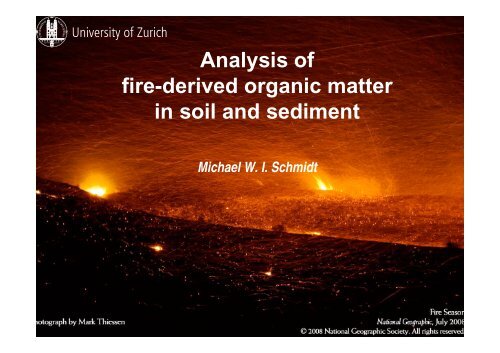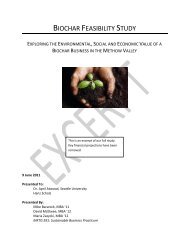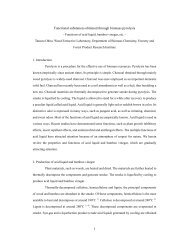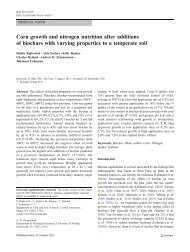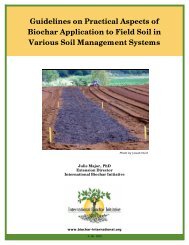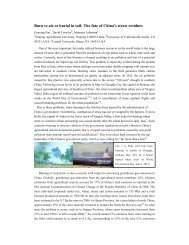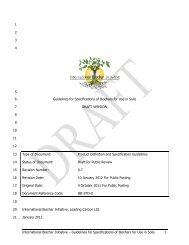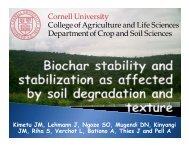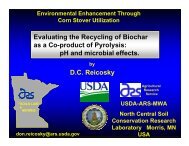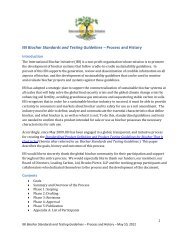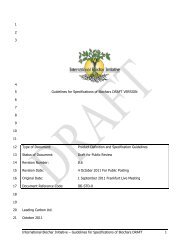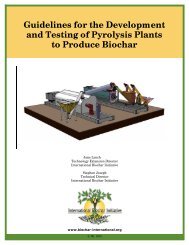Analysis of fire-derived organic matter in soil and sediment
Analysis of fire-derived organic matter in soil and sediment
Analysis of fire-derived organic matter in soil and sediment
- No tags were found...
Create successful ePaper yourself
Turn your PDF publications into a flip-book with our unique Google optimized e-Paper software.
<strong>Analysis</strong> <strong>of</strong><strong>fire</strong>-<strong>derived</strong> <strong>organic</strong> <strong>matter</strong><strong>in</strong> <strong>soil</strong> <strong>and</strong> <strong>sediment</strong>Michael W. I. Schmidt
Seven take-home messages- Not all char is created equal!- Besides black C there is black N!- Report (<strong>and</strong> stay with) protocols!- Calibrate with reference materials!- Potential methodological pitfallsBeyond quantificationwhat molecular markers can tell us about- degree <strong>of</strong> degradation- formation temperature
The Black Carbon Cont<strong>in</strong>uumPrecursor biomass Combustion residues Combustion condensatesCharcoalSoot(Hammes et al., 2007)
Schmidt & Noack 2000. Global Biogeochemical Cycles 14, 777-794.
Especially low temperature biomass burn<strong>in</strong>g forms black N (O, S...),besides black C13C NMR spectra <strong>of</strong> plant chars (b, e, h, <strong>and</strong> k)generated at 350 °C under oxic conditionsKnicker et al. 2008. Org. Geochem. 39, 935-939.
Conceptual model <strong>of</strong> SOM stabilization(very) simplified <strong>and</strong> modified afterLützow et al. 2008, Journal Plant Nutr. Soil Science 171, 111-124.A C T I V E P O O Lplant residues & exudatesmicrobial / faunal biomass & residuesI N T E R M E D I A T E P O O L1 - 10 yr10 - 100 yrdecomposed residuesmicrobial / faunal biomass & residuesP A S S I V E P O O L > 100 yrcharcoalhumic polymerspseudo-macromolecules<strong>in</strong>tercalated OMOM <strong>in</strong> clay microstructuresorgano-m<strong>in</strong>eral associationsPools with<strong>in</strong> brokenl<strong>in</strong>es <strong>in</strong>dicate postulatedpools but their existenceis not verified by directmeasurementsTransport <strong>of</strong> DOM & colloids
all C-species aromatics aliphaticscarboxyl phenolics all C-speciesComplexity <strong>of</strong> <strong>soil</strong> <strong>organic</strong> carbon forms at nanometre scalesmicroassemblage from forest <strong>soil</strong> determ<strong>in</strong>ed by NEXAFS / STXM(Lehmann et al. 2008. Nature Geoscience 1, 238 - 242).
A basic model <strong>of</strong> a complex char particle <strong>in</strong> <strong>soil</strong> with crystall<strong>in</strong>e,graphene-like sheets + r<strong>and</strong>omly ordered amorphous aromaticstructures <strong>and</strong> pores (Hammes & Schmidt 2008).
How? Methods to measure BCOrganic CarbonBlack Carbon Biomass Rema<strong>in</strong>sChar-BC Soot-BCIn<strong>organic</strong>Carbonates1 Separation• Optical• Thermal• Chemical2 Identification / Quantificationweigh<strong>in</strong>g, count<strong>in</strong>g, elemental analysis (CHNO),13C NMR, …
The steer<strong>in</strong>g committeeMichael W. I. Schmidt - University <strong>of</strong> Zurich, Dept. <strong>of</strong> Geography, Zurich, Switzerl<strong>and</strong>Jan O. Skjemstad - CSIRO L<strong>and</strong> <strong>and</strong> Water, Adelaide, AustraliaCarol<strong>in</strong>e Masiello - Rice University, Houston USAWilliam P. Ball - Johns Hopk<strong>in</strong>s University, Ort, USALloyd Currie - NIST, Gaithersburg, USADwight M. Smith - University <strong>of</strong> Denver, Denver USAThe Black Carbon R<strong>in</strong>g Trial TeamMichael W. I. Schmidt, Karen Hammes (University <strong>of</strong> Zurich, Dept. <strong>of</strong> Geography, Zurich, Switzerl<strong>and</strong>)Örjan Gustaffson, M. Elmquist, G. Cornelissen (Stockholm University, Institute <strong>of</strong> Applied Environmental Research (ITM), Sweden)Wiliam P. Ball, M. Fukudome, T.H. Nguyen (Johns Hopk<strong>in</strong>s University Dept. <strong>of</strong> Geography <strong>and</strong>Environmental Eng<strong>in</strong>eer<strong>in</strong>g, USA)Wulf Amelung, Sonja Brodowski (Institute for Ecology, Technical University Berl<strong>in</strong>, Germany Dept. <strong>of</strong> SoilScience <strong>and</strong> Soil Geography, University <strong>of</strong> Bayreuth, Germany)Georg Gugenberger, Klaus Kaiser, Andrei Rodionov (Institute for Soil Science <strong>and</strong> Plant Nutrition, Mart<strong>in</strong> LutherUniversity Halle-Wittenberg, Germany)L<strong>in</strong> Huang, Wendy Zhang (Stable Isotope Laboratory, Air Quality Research Branch, Meteorological Service <strong>of</strong> Canada,Environment Canada, Canada)Barry J. Huebert (Department <strong>of</strong> Oceanography, University <strong>of</strong> Hawaii, USA)Claude Largeau, Jean-Noël Rouzaud, Cornelia Rumpel (Laboratoire de Chimie Bioorganique et Organique Physique, EcoleNationale Supérieure de Chimie de Paris, France Laboratoire de Géologie, Ecole Normale- Supérieure, Paris, France)Luyi D<strong>in</strong>g (<strong>Analysis</strong> <strong>and</strong> Air Quality Division, Environmental Technology Center, Ontario, Canada)Jan O. Skjemstad, Ron J. Smernik (CSIRO L<strong>and</strong> <strong>and</strong> Water, Glen Osmond, Australia Department <strong>of</strong> Soil <strong>and</strong>Water, University <strong>of</strong> Adelaide, Glen Osmond, Australia)J<strong>in</strong>azhong Song, P<strong>in</strong>g’an Peng (State Key Laboratory <strong>of</strong> Organic Geochemistry, Guangzhou Institute <strong>of</strong> Geochemistry,Ch<strong>in</strong>ese Academy <strong>of</strong> Sciences, Ch<strong>in</strong>a)Patrick Louchouarn, Stephane Houel (Dept. <strong>of</strong> Earth <strong>and</strong> Environmental Sciences, Lamont-Doherty Earth Observatory <strong>and</strong> Earth Institute,Columbia University, New York, USA)Sid Mitra, Joshua C. Dunn (Department <strong>of</strong> Geological Sciences <strong>and</strong> Environmental Studies, B<strong>in</strong>ghamton University, B<strong>in</strong>ghamton, New York, USA)Patrick Hatcher, William C. Hockaday (Environmental Molecular Science Institute, Ohio State University, Columbus USA)Philip M. Gschwend, Xanat Flores (Massachusetts Institute <strong>of</strong> Technology, Cambridge, USA)Francisco Gonzalez-Vila, José A. Gonzalez-Perez, José Maria de la Rosa, O. Polvillo (Dpt. Biogeoquímica y D<strong>in</strong>ámica deContam<strong>in</strong>antes, Instituto de Recursos Naturales y Agrobiología de Sevilla (IRNAS-CSIC), Spa<strong>in</strong>)Christoph Hartkopf-Fröder, Axel Böhmer, Burkhard Lüer (Geologischer Dienst NRW, Gemany)
How? Methods <strong>in</strong> briefPretreatmentOxidationBC determ<strong>in</strong>ation(except air dry<strong>in</strong>g)CTO 375Carbonate removalwith HCl375 °C for 18 - 24 hMass + elementalanalysisThermal/opticalCarbonate removalwith HCl2 heat<strong>in</strong>g steps:Heat to 550 °CCool downReflectance/transmittanceHe-Ne laser beam(632 nm)Heat to 800 °C - 900 °CChemicalTFA-extracted at 105 °C,4 hHNO 3at 170 °C, 8 hBPCA molecularmarkers, GC/MS, /FIDHCL-dem<strong>in</strong>eralisationNaClO 23x 4 h13C MAS NMRWet sieved < 53 umUV photo-oxidation13C MAS NMRHF-dem<strong>in</strong>eralisationCN, mass differenceHCl - dem<strong>in</strong>eralisationK 2Cr 2O 7-H 2SO 4at22.5 °C, 55 °C, 80 °C for 24h - 400 hElemental analysis
What? 12 BC-reference materials x 20 teams4 x pure compounds- soot- wood char- grass char- no-BC sample (blank): melanoid<strong>in</strong>8 x BC <strong>in</strong> environmental matrix- urban aerosol- 2 <strong>soil</strong>s: clay <strong>soil</strong>, - s<strong>and</strong> <strong>soil</strong>- mar<strong>in</strong>e (harbour) <strong>sediment</strong>- water filtrate- 3 rocks with different aromaticity which could be false positive(shale < lignite coal < bitum<strong>in</strong>ous coal)1. Intra-laboratory,2. Inter-laboratory (with<strong>in</strong>-method)3. Inter-methodHammes et al. 2006, 2008a b
‘Pure’ BC: Soot & char* * *(*)* sp<strong>in</strong>n<strong>in</strong>g sideb<strong>and</strong>s (technical artifact)(*) partly sp<strong>in</strong>n<strong>in</strong>g sideb<strong>and</strong>sHammes, Smernik, Skjemstad, Schmidt 2008, Applied Geochemistry 23, 2113
BC <strong>in</strong> <strong>soil</strong> & <strong>sediment</strong>Hammes, Smernik, Skjemstad, Schmidt 2008, Applied Geochemistry 23, 2113
- Report (<strong>and</strong> stay with) protocols!- Calibrate with reference materials!Correlation plot <strong>of</strong> results from two <strong>soil</strong>s show<strong>in</strong>g a) broadsystematc differences <strong>and</strong> b) major discrepancies for some labscircles <strong>of</strong>f the best fit l<strong>in</strong>e (Hammes et al. 2007)
Conceptual summary <strong>of</strong> the r<strong>in</strong>g trial results (Hammes et al. 2007)A: CTO 375, B: BPCA, C: Cr 2 O 7 , D: TOT/R, E: TG DSC, F: NaClO,G: UV.
Wrap upIntra-laboratory: reproducibility mostly goodInter-laboratory: (with<strong>in</strong>-method) reproducibilitycan be good, when applied to materials method developed for(but less good for other)Inter-method:- strengths <strong>of</strong> <strong>in</strong>dividual methods- Report (<strong>and</strong> stay with) protocols!- Calibrate with reference materials!
- Potential methodological pitfalls
Oxidation resistant <strong>organic</strong> carbon is not always pyrogenic (black C)but <strong>in</strong> <strong>soil</strong> could also be paraf<strong>in</strong>ic C (e.g .from plant waxes).13C NMR spectra <strong>of</strong> plant <strong>fire</strong>-unaffected <strong>soil</strong>s after oxidation for 2-6 hwith K-dichromate (K 2 Cr 2 O 7 / 2M H 2 SO 4 )Knicker et al. 2008. Geoderma 142, 178-196.
www.geo.uzh.ch/phys/bc
- Application <strong>in</strong> the field
How quickly will black carbon stocks decrease after BC<strong>in</strong>puts (wild<strong>fire</strong>) have stopped for 100 years?
Was there a change <strong>in</strong> black carbon stock over time?1900100 years no <strong>fire</strong>----------------->>1997Hammes, Torn, Lapenas, Schmidt 2008Biogeosciences 5, 1339-1350.Photo: Karen Hammes
24 % black carbon stock loss over 100 yearsHammes, Torn, Lapenas, Schmidt 2008Biogeosciences 5, 1339-1350.
293 years(210-540 years)A significant amount <strong>of</strong> black carbon turns overfaster than previously thoughtTurnover model assumptions:1. BC is homogenous2. BC loss is first order decay3. BC <strong>in</strong>puts decreased with decreas<strong>in</strong>g <strong>fire</strong>t = -t/ln(f-b/(f-1)Hammes, Torn, Lapenas, Schmidt 2008Biogeosciences 5, 1339-1350.
Beyond quantificationwhat molecular markers can tell us about- degree <strong>of</strong> degradation- formation temperature
Beyond quantification: BPCA method providesstructural <strong>in</strong>formation, tooOxidation(HNO 3 65%,170°C, 8h)COOHCOOHCOOHhemimellitic acid(example for B3CA)COOHHOOCCOOHCOOHprehnitic acid(example for B4CA)COOHHOOCCOOHHOOCCOOHHOOCCOOHCOOHmellitic acid(B6CA)(Akhter et al., 1985)HOOCCOOHCOOHpentacarboxylic acid(B5CA)Benzene polycarboxylic acid (BPCA) method(Glaser et al. 1998, Brodowski et al. 2005)
Less-condensed (easily degradable) BC decreased,Highly condensed (more recalcitrant) BC survivedover 100 yearsBPCA Stock (kg C m -2 )1900 2000B3CAB4CAB5CAB6CABenzene polycarboxylic acid (BPCA) pattern <strong>of</strong> black carbon as <strong>in</strong>fluenced by time 1990 vs 2000.(B3CA = ∑ hemimellitic, trimellitic, trimesic acids; B4CA = ∑ pyromellitic, prehnitic, mellophanic acis; B5CA= benzene pentacarboxylic acid; B6CA = mellitic acid) Hammes et al. 2008.
Black carbon contents <strong>of</strong> chestnut chars300250OC] -1200150BPCA-C [g kg100500200 250 300 400 500 600 700 1000n=3 (analytical replicates)Temperature [°C]Schneider, Hilf, Schmidt, poster 743-3 404, Wednesday 4pm exhibit hall E
BPCA patterns <strong>of</strong> wood charsB6CA: mellitic acidB5CA: pentacarboxylic acidB4CA: pyromellitic, prehnitic, mellophanic acidB3CA: hemimellitic <strong>and</strong> trimellitic acid10080604020Relative contrib0200 250 300 400 500 600 700 800 900 1000Pyrolysis temperature [°C]
BPCA ratios - a „thermometer“ for pyrolized wood(<strong>and</strong> maybe other species?)4030B6CA/ B5CAB6CA/ (sum B3CA;B4CA;B5CA)Ratioratio x 1002010y= 0.089*1.006 xr²=0.99200 200 400 600 800 1000 1200n=3 (analytical replicates)Temperature [°C]Schneider, Hilf, Schmidt, poster 743-3 404, Wednesday 4pm exhibit hall E
Us<strong>in</strong>g Black carbon molecular markers toestimate the formation temperature <strong>of</strong>natural charsMaximilian P. Schneider, M. Hilf, M. W.I. SchmidtCome <strong>and</strong> see poster 743-3 404Wednesday 4pm exhibit hall E
With chang<strong>in</strong>g climate, summers will be dryer <strong>and</strong>the number <strong>of</strong> wild<strong>fire</strong>s will <strong>in</strong>crease.What will wildires do to our ecosystem carbon budget?Preston & Schmidt 2006. Biogeosciences 3, 397-420
Career options <strong>in</strong> early 20091 postdoc + 1 PhD positionPlease contact meif you are <strong>in</strong>terested
Seven take-home messages- Not all char is created equal!- Besides black C there is black N!- Report (<strong>and</strong> stay with) protocols!- Calibrate with reference materials!- Potential methodological pitfallsBeyond quantificationwhat molecular markers can tell us about...- degree <strong>of</strong> degradation- formation temperature
<strong>Analysis</strong> <strong>of</strong><strong>fire</strong>-<strong>derived</strong> <strong>organic</strong> <strong>matter</strong><strong>in</strong> <strong>soil</strong> <strong>and</strong> <strong>sediment</strong>Michael W. I. Schmidt


